Nestled in the heart of Kyoto, the Fushimi Inari-taisha Shrine invites visitors on a captivating journey. Its iconic vermilion torii gates wind up the sacred Mount Inari, symbolizing the transition from the mundane to the sacred. Venturing off the main path, one can discover a serene bamboo forest, immersed in Kyoto’s natural beauty. But the true allure lies in the hidden local attractions, where a family-run restaurant serves up fresh, handmade soba noodles in a light, umami-rich broth – a glimpse into the city’s vibrant culinary culture.
Key Points
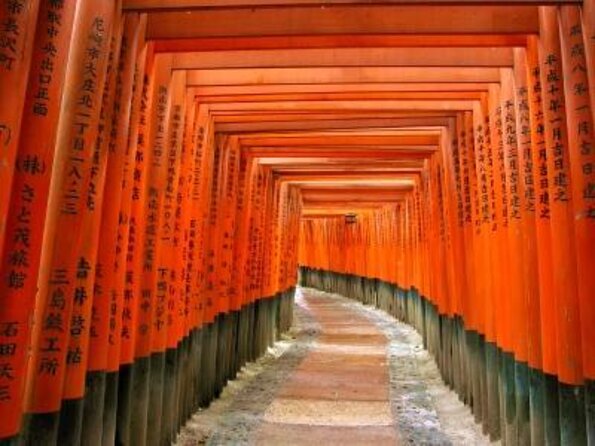
-
Immerse in the cultural significance of Fushimi Inari-taisha Shrine, exploring the iconic red torii gates and connecting with the spiritual essence of the site.
-
Venture off the beaten path into a serene bamboo forest, appreciating Kyoto’s natural beauty beyond the shrine.
-
Savor an authentic Japanese lunch of fresh, hand-made soba noodles, gaining insight into the local culinary culture.
-
Discover hidden local attractions, including lesser-known shrines, tranquil gardens, and family-run restaurants, for a deeper understanding of the city’s heritage.
-
Recharge with a refreshing Japanese tea and boiled egg break, experiencing the cultural traditions woven into Kyoto’s natural landscapes.
Meeting at Inari Station
Travelers meet at Inari Station, the designated meeting point for the half-day hiking tour. The guide greets the group and provides a quick overview of the day’s itinerary.
As everyone gets acquainted, the guide emphasizes the importance of staying together throughout the hike for safety and to ensure no one gets lost.
With bags packed and cameras ready, the group sets off from the station, eager to explore the iconic Fushimi Inari-taisha Shrine and the hidden gems along the path.
The guide leads the way, providing insights into the cultural significance of the shrine’s vibrant red torii gates and the tranquil bamboo forests they’ll encounter.
You can also read our reviews of more tours and experiences in Kyoto
Iconic Fushimi Inari-taisha Shrine
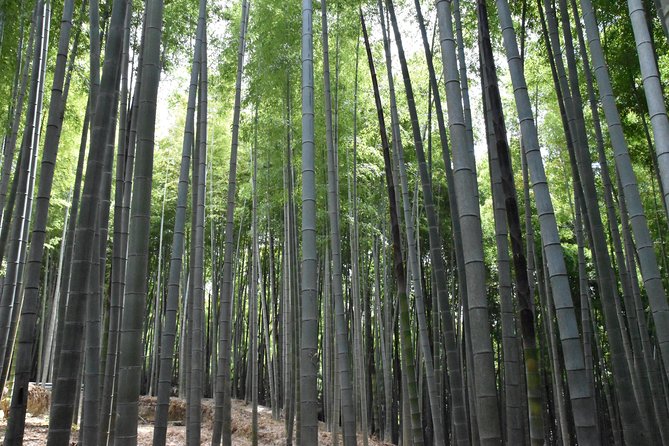
The group soon arrives at the iconic Fushimi Inari-taisha Shrine, one of Kyoto’s most famous landmarks.
This Shinto shrine is known for its thousands of vibrant red torii gates that wind up the sacred Mount Inari, creating a mesmerizing visual experience for visitors.
The guide explains the significance of the torii gates, which symbolize the transition from the mundane to the sacred.
As the group starts to climb the trails, they’re surrounded by the towering gates, each one donated by a Japanese business or individual.
Along the way, the guide points out smaller shrines and details the rituals and traditions of this important site.
Off-the-beaten-track Bamboo Forest Path
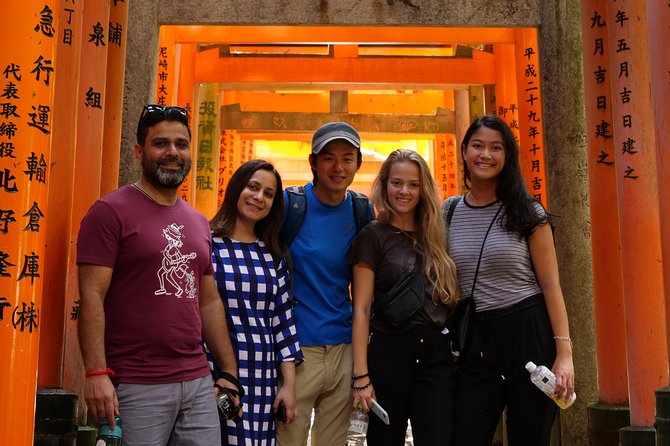
After taking in the grandeur of the iconic Fushimi Inari-taisha Shrine, the group ventures off the main path, weaving through a serene bamboo forest.
The lush, verdant landscape surrounds them as they follow the guide along this less-traveled trail, eager to discover hidden local attractions beyond the shrine’s famous torii gates.
The bamboo stalks tower overhead, creating a peaceful, tranquil atmosphere.
As they walk, the guide shares insights about the significance of the bamboo forests and their role in Japanese culture and spirituality.
The group takes in the sights and sounds of this off-the-beaten-track experience, appreciating the opportunity to explore Kyoto’s natural beauty beyond the well-known shrine.
Significance of Red Torii Gates
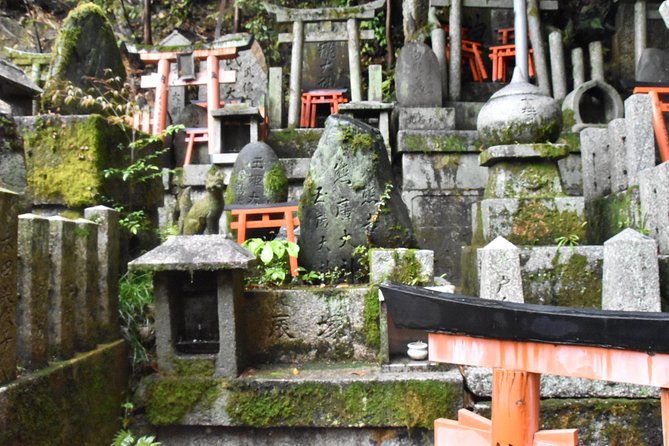
As the group emerges from the tranquil bamboo forest, their eyes are immediately drawn to the sea of vibrant red torii gates that characterize the Fushimi Inari-taisha Shrine.
These iconic gates, which line the pathways leading to the shrine, hold profound significance in Japanese culture and spirituality. The torii gates symbolize the transition from the mundane world to the sacred realm of the shrine.
They represent the boundary between the physical and spiritual realms, serving as gateways that allow worshippers to connect with the Shinto deities. The striking red color of the gates is believed to ward off evil spirits and purify those who pass through them.
This rich symbolism adds to the awe-inspiring experience of exploring Fushimi Inari.
Reaching the Summit

Traversing the winding paths, the group climbs higher, their sights set on the summit of the Fushimi Inari-taisha Shrine. The dense bamboo forests give way to spectacular vistas, offering breathtaking panoramas of Kyoto.
As they ascend, the significance of the vermilion torii gates becomes increasingly apparent. The group learns that reaching the summit symbolizes:
- Overcoming challenges and obstacles in life.
- Attaining a higher perspective and deeper understanding.
- Connecting with the spiritual essence of the shrine.
- Appreciating the beauty and tranquility of the natural surroundings.
With each step, the group feels a growing sense of accomplishment and connection to the centuries-old traditions of this iconic Shinto shrine.
Hidden Local Attractions
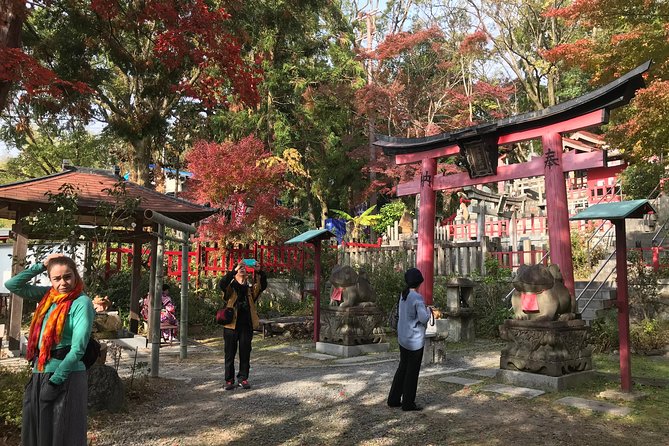
Upon reaching the summit, the group doesn’t just turn back, but explores a hidden network of local attractions tucked away from the main tourist paths.
They discover lesser-known shrines, tranquil gardens, and charming tea houses that offer a more intimate glimpse into traditional Kyoto life.
At one shrine, the guide explains the significance of the intricate carvings and statues, allowing the travelers to appreciate the deep cultural heritage.
In a serene garden, they pause to admire the carefully curated landscape and enjoy a soothing cup of matcha tea.
The group also stumbles upon a small family-run restaurant where they savor authentic Kyoto cuisine, interacting with the local owners and gaining a deeper understanding of the city’s vibrant food culture.
Soba Noodle Lunch

The guided tour culminates with a nourishing soba noodle lunch, where travelers savor the delicate flavors and textures of this quintessential Japanese dish.
The fresh, hand-made soba noodles are served in a light, umami-rich broth, accompanied by an array of toppings that may include tempura, green onions, and a soft-boiled egg.
This simple yet satisfying meal provides a chance to:
- Refuel and recharge after the morning’s hike.
- Immerse in the local culinary culture.
- Engage in conversation with the guide and fellow travelers.
- Appreciate the care and craftsmanship that goes into preparing an authentic Japanese lunch.
The soba noodle lunch is a fitting conclusion to the Fushimi Inari adventure, leaving participants with a deeper understanding and appreciation of Kyoto’s rich heritage.
Japanese Tea and Snacks
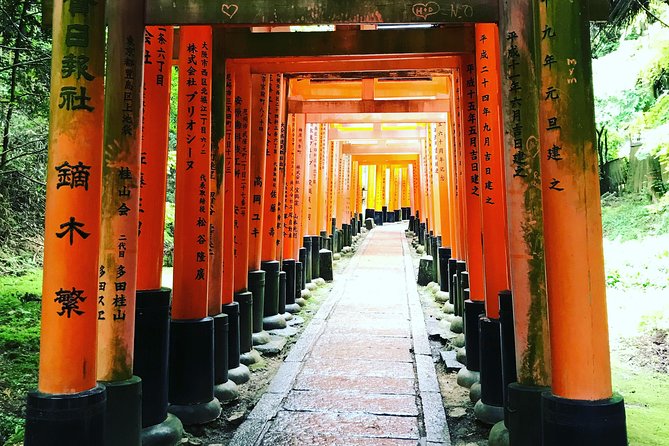
Along With the soba noodle lunch, the guided tour also includes a refreshing Japanese tea and boiled egg break, providing participants with a chance to savor traditional local refreshments and recharge amidst the serene surroundings. This break allows hikers to fuel up with a nutritious snack and rehydrate with a calming cup of tea, all while taking in the tranquil atmosphere of the bamboo forests and shrines. The experience offers a glimpse into the cultural traditions that are deeply woven into the fabric of Kyoto’s natural landscapes.
| Purpose | Benefits |
|---|---|
| Refreshment | Rehydration and energy boost |
| Cultural experience | Appreciation for local traditions |
| Recharge | Renewed energy for the rest of the hike |
| Peaceful setting | Chance to pause and savor the surroundings |
| Balanced nutrition | Sustenance from the boiled egg |
Frequently Asked Questions
Can I Bring My Pet on the Tour?
No, pets are not allowed on this small-group hiking tour. The tour is not wheelchair accessible and is not recommended for travelers with certain medical conditions, so it’s unlikely to accommodate pets. Travelers should have a moderate fitness level for this activity.
Is It Possible to Extend the Tour Duration?
The tour duration can be extended for an additional fee, subject to availability. Travelers should inquire with the tour provider about extending the tour length to meet their needs and preferences.
How Accessible Is the Tour for Individuals With Mobility Issues?
The tour is not wheelchair accessible and is not recommended for travelers with mobility issues, such as those with back problems or serious medical conditions. Participants should have a moderate level of physical fitness to complete the hike.
Can the Tour Be Customized to Accommodate Dietary Restrictions?
The tour can accommodate dietary restrictions like vegetarian, halal, and gluten-free options. Travelers simply need to request their preference when booking, and the tour provider will make the necessary arrangements.
What Is the Policy for Rescheduling the Tour Due to Personal Reasons?
The tour can be rescheduled if you need to change the date due to personal reasons, but you must notify the provider at least 24 hours in advance. Changes made less than 24 hours prior are not accepted.
Recap
The tour of Fushimi Inari-taisha Shrine and the surrounding areas offers a captivating blend of cultural, natural, and culinary experiences.
From the iconic vermilion torii gates to the serene bamboo forest and the mouthwatering soba noodle lunch, visitors gain a deeper understanding of Kyoto’s rich heritage and vibrant local traditions.
This immersive journey seamlessly connects the sacred and the mundane, leaving a lasting impression on all who venture through this remarkable destination.
More Lunch Experiences in Kyoto
- [Japan Wellness] White Miso Cooking Class and Lunch in Kyoto
- A Private Lunch at the Ramen Restaurant in Gion, Kyoto
- Hiroshima, Miyajima 1 Day Bus With Indian Lunch From Osaka, Kyoto
- Kyoto Walking Tour With Kimono Rental Lunch and Tea Ceremony
- [Japan Wellness] A Tour of Four Springs, Tofu Lunch, and Matcha
- Nishiki Market Lunch Tour
More Tour Reviews in Kyoto
- Kyoto: Discover Every Bit of Ginkakuji Temple in 60 Minutes
- Private Full-Day Walking Tour of Kyoto
- Hidden Temples in Kyoto a Self-Guided Zen Tour
- 2 Hour Private Tour of Arashiyama Highlights
- Nara 9hr Tour Licensed Guide&Vehicle: Kyoto Pickup/Osaka Dropoff
- Kyoto: Half-Day Private Tour Gion Geisha Districts & Kiyomizu
Not for you? Here's more nearby things to do in Kyoto we have reviewed
- Hidden Kyoto- Countryside & Local Life – Private Car Tour
- Kyoto: Discover Every Bit of Ginkakuji Temple in 60 Minutes
- Private Full-Day Walking Tour of Kyoto
- Hidden Temples in Kyoto a Self-Guided Zen Tour
- 2 Hour Private Tour of Arashiyama Highlights
- One Way Bus From Kanazawa to Kyoto
- Nara 9hr Tour Licensed Guide&Vehicle: Kyoto Pickup/Osaka Dropoff
- Original Pizza Making Using Kyoto Vegetable at BNR Night Farm
- Kyoto 8 Hr Tour From Osaka: English Speaking Driver, No Guide
- Kyoto: Half-Day Private Tour Gion Geisha Districts & Kiyomizu
- Kyoto Sweets & Desserts Tour With a Local Foodie: Private & Custom
- Arashiyama Autumn Leaves & Sanzen-In Temple Tour From Osaka/Kyoto
